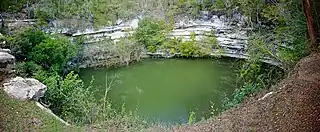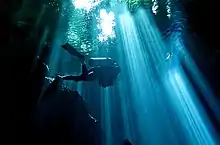Cenote
A cenote (English: /sɪˈnoʊti/ or /sɛˈnoʊteɪ/; Latin American Spanish: [seˈnote]) is a natural pit, or sinkhole, resulting from the collapse of limestone bedrock that exposes groundwater. The term originated on the Yucatán Peninsula of Mexico, where cenotes were commonly used for water supplies by the ancient Maya, and occasionally for sacrificial offerings. The term derives from a word used by the lowland Yucatec Maya—tsʼonoʼot—to refer to any location with accessible groundwater.[3]

The Yucatán Peninsula alone has an estimated 10,000 cenotes,[4] water-filled sinkholes naturally formed by the collapse of limestone, located across the Yucatán Peninsula, in Mexico. Some of these cenotes are at risk from the construction of the new tourist Maya Train.[4]
Cenotes are common geological forms in low-altitude regions, particularly on islands, coastlines, and platforms with young post-Paleozoic limestone with little soil development. The term cenote, originally used only to describe the features in Yucatán, has since been applied to similar karst features in other countries such as Cuba, Australia, and the United States.
Definition and description

Cenotes are surface connections to subterranean water bodies.[5] While the best-known cenotes are large open-water pools measuring tens of meters in diameter, such as those at Chichen Itza in Mexico, the greatest number of cenotes are smaller sheltered sites and do not necessarily have any surface exposed water. Some cenotes are only found through small <1 m (3 ft) diameter holes created by tree roots, with human access through enlarged holes, such as the cenotes Cenote Choo-Ha, Tamcach-Ha, and Multum-Ha near Tulum. There are at least 6,000 cenotes in the Yucatán Peninsula of Mexico.[6] Cenote water is often very clear, as the water comes from rain water filtering slowly through the ground, and therefore contains very little suspended particulate matter. The groundwater flow rate within a cenote may be very slow. In many cases, cenotes are areas where sections of the cave roof have collapsed revealing an underlying cave system, and the water flow rates may be much faster: up to 10 kilometers (6 mi) per day.[7]
The Yucatan cenotes attract cavern and cave divers who have documented extensive flooded cave systems, some of which have been explored for lengths of 376 km (234 mi) or more.[8]
Geology and hydrology
.jpg.webp)
Cenotes are formed by the dissolution of rock and the resulting subsurface void, which may or may not be linked to an active cave system, and the subsequent structural collapse. Rock that falls into the water below is slowly removed by further dissolution, creating space for more collapse blocks. Likely, the rate of collapse increases during periods when the water table is below the ceiling of the void since the rock ceiling is no longer buoyantly supported by the water in the void.
Cenotes may be fully collapsed, creating an open water pool, or partially collapsed with some portion of a rock overhanging above the water. The stereotypical cenotes often resemble small circular ponds, measuring some tens of meters in diameter with sheer rock walls. Most cenotes, however, require some degree of stooping or crawling to access the water.
Penetration and extent

In the north and northwest of the Yucatán Peninsula in Mexico, the cenotes generally overlie vertical voids penetrating 50 to 100 m (160 to 330 ft) below the modern water table. However, very few of these cenotes appear to be connected with horizontally extensive underground river systems, with water flow through them being more likely dominated by aquifer matrix and fracture flows.[7]
In contrast, the cenotes along the Caribbean coast of the Yucatán Peninsula (within the state of Quintana Roo) often provide access to extensive underwater cave systems, such as Sistema Ox Bel Ha, Sistema Sac Actun/Sistema Nohoch Nah Chich and Sistema Dos Ojos.
Freshwater/seawater interface
The Yucatán Peninsula contains a vast coastal aquifer system, which is typically density-stratified.[7] The infiltrating meteoric water (i.e., rainwater) floats on top of higher-density saline water intruding from the coastal margins. The whole aquifer is therefore an anchialine system (one that is land-locked but connected to an ocean). Where a cenote, or the flooded cave to which it is an opening, provides deep enough access into the aquifer, the interface between the fresh and saline water may be reached. The density interface between the fresh and saline waters is a halocline, which means a sharp change in salt concentration over a small change in depth. Mixing of the fresh and saline water results in a blurry swirling effect caused by refraction between the different densities of fresh and saline waters.
The depth of the halocline is a function of several factors: climate and specifically how much meteoric water recharges the aquifer, hydraulic conductivity of the host rock, distribution and connectivity of existing cave systems, and how effective these are at draining water to the coast, and the distance from the coast. In general, the halocline is deeper further from the coast, and in the Yucatán Peninsula this depth is 10 to 20 m (33 to 66 ft) below the water table at the coast, and 50 to 100 m (160 to 330 ft) below the water table in the middle of the peninsula, with saline water underlying the whole of the peninsula.[7]

Types
In 1936, a simple morphometry-based classification system for cenotes was presented.[9]
- Cenotes-cántaro (Jug or pit cenotes) are those with a surface connection narrower than the diameter of the water body;
- Cenotes-cilíndricos (Cylinder cenotes) are those with strictly vertical walls;
- Cenotes-aguadas (Basin cenotes) are those with shallow water basins; and
- Grutas (Cave cenotes) are those having a horizontal entrance with dry sections.
The classification scheme was based on morphometric observations above the water table, and therefore incompletely reflects the processes by which the cenotes formed and the inherent hydrogeochemical relationship with the underlying flooded cave networks, which were only discovered in the 1980s and later with the initiation of cave diving exploration.
Flora and fauna
Flora and fauna are generally scarcer than in the open ocean; however, marine animals do thrive in caves. In caverns, one can spot mojarras, mollies, guppies, catfish, small eels and frogs. In the most secluded and darker cenotes, the fauna has evolved to resemble those of many cave-dwelling species. For example, many animals don't have pigmentation and are often blind, so they are equipped with long feelers to find food and make their way around in the dark.[10]
Chicxulub crater

Although cenotes are found widely throughout much of the Yucatán Peninsula, a higher-density circular alignment of cenotes overlies the measured rim of the Chicxulub crater. This crater structure, identified from the alignment of cenotes,[11] but also subsequently mapped using geophysical methods (including gravity mapping) and also drilled into with core recovery, has been dated to the boundary between the Cretaceous and Paleogene geologic periods, 66 million years ago. This meteorite impact at the Cretaceous–Paleogene boundary is therefore associated with the mass extinction of the dinosaurs and is also known as the Cretaceous–Paleogene extinction event.[12]
Archaeology and anthropology
In 2001–2002 expeditions led by Arturo H. González and Carmen Rojas Sandoval in the Yucatán discovered three human skeletons; one of them, Eve of Naharon, was carbon-dated to be 13,600 years old.[13][14][15] In March 2008, three members of the Proyecto Espeleológico de Tulum and Global Underwater Explorers dive team, Alex Alvarez, Franco Attolini, and Alberto Nava, explored a section of Sistema Aktun Hu (part of Sistema Sac Actun) known as the pit Hoyo Negro.[14][16] At a depth of 57 m (187 ft) the divers located the remains of a mastodon and a human skull (at 43 m [141 ft]) that might be the oldest evidence of human habitation in the region.[14]
The Yucatán Peninsula has almost no rivers and only a few lakes, and those are often marshy.[17] The widely distributed cenotes are the only perennial source of potable water and have long been the principal source of water in much of the region. Major Maya settlements required access to adequate water supplies, and therefore cities, including the famous Chichen Itza, were built around these natural wells. Many cenotes like the Sacred Cenote in Chichen Itza played an important role in Maya rites. The Maya believed that cenotes were portals to Xibalba or the afterlife, and home to the rain god, Chac.[18] The Maya often deposited human remains as well as ceremonial artifacts in these cenotes.
The discovery of golden sacrificial artifacts in some cenotes led to the archaeological exploration of most cenotes in the first part of the 20th century. Edward Herbert Thompson (1857–1935), an American diplomat who had bought the Chichen Itza site, began dredging the Sacred Cenote there in 1904. He discovered human skeletons and sacrificial objects confirming a local legend, the Cult of the Cenote, involving human sacrifice to the rain god Chaac by the ritual casting of victims and objects into the cenote.[19] However, not all cenotes were sites of human sacrifice. The cenote at Punta Laguna has been extensively studied and none of the approximately 120 individuals show signs of sacrifice.[20] The remains of this cultural heritage are protected by the UNESCO Convention on the Protection of the Underwater Cultural Heritage.[21]
Scuba diving

Cenotes have attracted cavern and cave divers, and there are organized efforts to explore and map these underwater systems. They are public or private and sometimes considered "National Natural Parks". Great care should be taken to avoid spoiling this fragile ecosystem when diving. In Mexico, the Quintana Roo Speleological Survey maintains a list of the longest and deepest water-filled and dry caves within the state boundaries. When cavern diving, one must be able to see natural light the entire time that one is exploring the cavern (e.g., Kukulkan cenote near Tulum, Mexico). During a cave dive, one passes the point where daylight can penetrate, and one follows a safety guideline to exit the cave. Things change quite dramatically once moving from a cavern dive into a cave dive. Too many divers, even experienced ones, have died for ignoring safety recommendations.[22]
Contrary to cenote cavern diving, cenote cave diving requires special equipment and training (certification for cave diving). However, both cavern and cave diving require detailed briefings, diving experience, and weight adjustment to freshwater buoyancy. The cenotes are usually filled with rather cool fresh water. Cenote divers must be wary of possible halocline; this produces blurred vision until they reach a more homogeneous area.
Notable cenotes
Australia
- Ewens Ponds, near Mount Gambier, South Australia
- Kilsby Sinkhole, near Mount Gambier, South Australia
- Little Blue Lake, near Mount Schank, South Australia
Bahamas
- Thunderball Grotto, on Staniel Cay
Belize
Canada
- Devil's Bath is the largest cenote in Canada at a size of 1178 ft (359m) in diameter and 144 ft (44m) in depth.[23] It is located near the village of Port Alice, British Columbia on the northwest coastline of Vancouver Island. Devil's Bath is continuously fed by an underground spring and is connected by underwater tunnel to the Benson River Cave.[24]
Dominican Republic
- Hoyo Azul (Punta Cana)
- Los Tres Ojos
- Ojos Indigenas (Punta Cana)
Greece
- Melissani Cave, Kefalonia
Jamaica
- Blue Hole (Ocho Rios)
Yucatán Peninsula
- Dos Ojos, Municipality of Tulum
- Dzibilchaltun, Yucatán
- Ik Kil, Yucatan
- Gran Cenote, Municipality of Tulum
- Hubiku, Yucatan
- Sacred Cenote, Chichen Itza
- Xtacunbilxunan, Bolonchén
- Cenote Azul, Playa del Carmen
- Jardin Del Eden, Bacalar
- Choo-Ha, Coba
- Zaci, Valladolid
- El Zapote, the site of the Hells Bells bell-like rock formation
United States
- Blue Hole, Santa Rosa, New Mexico
- Blue Hole, Castalia, Ohio
- Bottomless Lakes, near Roswell, New Mexico
- Montezuma Well, Verde Valley, Arizona
- Hamilton Pool, Austin, Texas
Zimbabwe
See also
- Aquifer – Underground layer of water-bearing permeable rock
- Blue hole – Marine cavern or sinkhole, open to the surface, in carbonate bedrock
- Karst – Topography from dissolved soluble rocks
- Quintana Roo Speleological Survey – Data repository for explored sites within the state of Quintana Roo
- Saltwater intrusion – Movement of saline water into freshwater aquifers
- Sinkhole – Geologically-formed topological depression
- List of sinkholes – Links to Wikipedia articles on sinkholes, blue holes, dolines, cenotes, and pit caves
References
Citations
- Cenote Hubiku - Temozón, Mexico | Atlas Obscura
- Tim Scoones (producer), Jeff Goodman (photography), Dominique Rissolo (scientific adviser), Tom Iliffe (sci adv), Patricia Beddows (sci adv), Jill Yager (sci adv) (2005). Secrets of the Maya Underworld (Television production). BBC/Discovery Channel. Event occurs at 3:07. Retrieved June 8, 2010.
- Soraya Kishwari (12 January 2023). "A New Tourist Train in Mexico Will Destroy Indigenous Land and Livelihoods". Time.
- Gaona-Vizcayno, S; Gordillo de Anda, T; M. Villasuso-Pino, M (1980). Cenotes, karst característico: Mecanismo de formacíon, Instituto de Geología, v. 4; pp 32–36.
- Lysakowska, Anna (2016-05-30). "The Best Cenotes in Mexico: Ultimate Guide | Anna Everywhere". Anna Everywhere. Retrieved 2017-01-20.
- Beddows, PA (2003). "Yucatan Phreas, Mexico". In Gunn, John (ed.). Encyclopaedia of Cave and Karst Science. New York, USA: Routledge Taylor & Francis Group. pp. 794–796. ISBN 978-1-57958-399-6.
- "Long Underwater Caves".
- Hall, F.G. (1936), Physical and chemical survey of cenotes of Yucatán, Carnegie Institution of Washington Publication 457, pp 5–16.
- Medina-González, Roger M. (1995). "Aspectos biologicos de los cenotes de Yucatan" (PDF). www.seduma.yucatan.gob.mx. UADY-FMVZ-Biología, Departamento de Ecología. Archived from the original (PDF) on 2015-05-01. Retrieved 2017-09-20.
- Pope, KO; Ocampo, AC; Kinsland, GL; Smith, R (1996). "Surface expression of the Chicxulub crater". Geology. 24 (6): 527–30. Bibcode:1996Geo....24..527P. doi:10.1130/0091-7613(1996)024<0527:SEOTCC>2.3.CO;2. PMID 11539331.
- Bottke, William F; Vokrouhlicky, David; Nesvorny, David (September 2007). "An asteroid breakup 160 Myr ago as the probable source of the K/T impactor" (PDF). Nature. 449 (7158): 48–53. Bibcode:2007Natur.449...48B. doi:10.1038/nature06070. PMID 17805288. S2CID 4322622.
- Floyd B. Largent Jr. (June 2005). "Early Humans South of the Border. New finds from the Yucatán Peninsula" (PDF). Mammoth Trumpet. 20 (3): 8–11. Retrieved February 20, 2011.
- Fabio Esteban Amador (February 18, 2011). "Skull in Underwater Cave May Be Earliest Trace of First Americans". NatGeo News Watch. National Geographic. Archived from the original on 2011-02-26. Retrieved February 19, 2011.
- Eliza Barclay (September 3, 2008). "Oldest Skeleton in Americas Found in Underwater Cave?". National Geographic News. National Geographic. Retrieved February 20, 2011.
- Fedick, Scott L (1998). Kathryn Bernick (ed.). Ancient Maya Use of Wetlands in Northern Quintanaa Roo, Mexico. ISBN 0-7748-0633-8. Retrieved January 16, 2011.
{{cite book}}:|work=ignored (help) - Romey, Kristin (2005). "Watery Tombs". Archaeology. 58 (4): 42–49.
- Munro, Paul; Maria de Lourdes Melo Zurita (2011). "The Role of Cenotes in the Social History of Mexico's Yucatan Peninsula". Environment and History. 17 (4): 583–612. doi:10.3197/096734011X13150366551616.
- "Tratamientos mortuorios en los cenotes". Arqueología Mexicana (in Spanish). 2016-11-01. Retrieved 2023-02-09.
- "Underwater Cultural Heritage". UNESCO. 2015. Retrieved 11 October 2015.
- "Association for Mexican Cave Studies, Activities, Newsletter, Number 33" (PDF). June 2010.
- "Alice Lake Loop Tour". Tourism Vancouver Island North. 2016. Retrieved 13 May 2016.
- "Port Alice Caving And Bouldering". Village of Port Alice. 2016. Archived from the original on 5 June 2016. Retrieved 13 May 2016.
Other sources
- RAE [Real Academia Española] (2001). Diccionario de la lengua española (in Spanish) (22nd ed.). Madrid: Editorial Espasa Calpe. ISBN 84-239-6814-6. OCLC 48657242. Archived from the original on 2010-02-06.
- Sharer, Robert J.; Loa P. Traxler (2006). The Ancient Maya (6th, fully revised ed.). Stanford, CA: Stanford University Press. ISBN 0-8047-4816-0. OCLC 28067148.